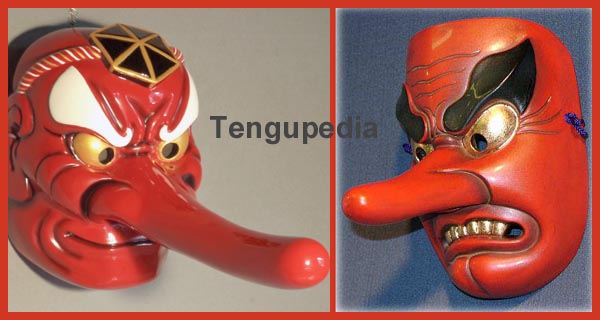. Tengupedia - 天狗ペディア - Tengu ABC-Index .
:::::::::::::::::::::::::::::::::::::::::::::::::::::::::::::::::::::::::::::::::::::::::::::::::::::::::::::::::::::::::::::::::::::::::::::::::::::::::::::::::::::::::::::::::::
Ashitateboo 足立坊 / アシタテボウ Ashitatebo, Ashitate-Bo
足立坊(あしだて) Ashidate-Bo
Myookoosan. Myōkōsan 妙高山 Myokosan - Niigata
He is one of the
. 四十八天狗 48 Tengu of Japan .
The mountain is also called Myookoosen 妙高山 Myokosen.

source : toki.moo.jp/gaten 800
Mount Myokosan used to be called 越の中山 Koshi no Nakayama (Mountain in the Middle of the Koshi region), with the Chinese characters
Nakayama 名香山. The Characters 名香 were then read myookoo, 名香山 Myokosan, and hence the name given to the mountain today.
Ashitatebo is related to the Tengu from 飯縄系天狗 Izuna, and also seen as incarnations of 荼吉尼天 Dakini Ten.
He is a protector deity of the Mountain.
. Dakini Ten, Dakiniten 荼枳尼天 Vajra Daakini .
In Myoko Town there is a shrine 関山神社 / 關山神社 Sekiyama Jinja dedicated to the first priest who climbed the mountain in 708 and founded the shrine:

裸行上人 Ragyo Shonin "the naked saint"
a monk who came from China around 350 and practised austerities near the rivers and waterfalls of Japan.
He even went to Kumano and the 那智滝 waterfall of Nachi. He was active in bringing the Kumano belief to the mountain region of Myokosan.
(Other sources state more than one "naked saint" to bring the Kumano belief to other parts of Japan.)
Since Ragyo was always naked during his austerity practise, he got this name.
He was later deified as 関山権現 Sekiyama Gongen .

source and more photos : shashinki.blog.fc2.com/blog
関山三所権現 Three Gongen from Sekiyama
The mountain itself became related to the Paradise of Amida Nyorai 阿弥陀如来の浄土.
At the top of the mountain is a hall with Amida in the middle and 観音 Kannon and 勢至 Seishi at his side.
Sekiyama Jinja is also related to the temple 妙高山雲上寺宝蔵院 Myokosan Unjo-Ji Hozo-In.
Another Buddhist temple hall:
天狗宝窟観音 Tengu Hokutsu Kannon
.......................................................................
The Waka poet Saigyo Hoshi composed the following poem on his travels through the region:
かりがねは歸(かへ)るみちにやまよふらん越(こし)の中山(なかやま)霞へだてて
karigane wa kaeru michi ni yama yoburan Koshi no Nakayama kasumi hedatete
. Saigyoo 西行法師 Saigyo Hoshi (1118 - 1190) .
..............................................................................................................................................

- quote
Mount Myōkō (妙高山 Myōkō-san)
is an active stratovolcano in Honshu, Japan. It is situated at the southwest of Myōkō city, Niigata Prefecture, and a part of Joshinetsu Kogen National Park. Mount Myōkō is listed as one of 100 Famous Japanese Mountains, and together with Mount Yahiko (弥彦山 Yahiko-yama), it is well known as the "famous mountain" of Niigata Prefecture.
Echigofuji (越後富士) is another name given to this mountain.
..... There are onsen and ski resorts at the foot of the mountain, including Akakura, Suginohara and Ikenotaira.
- source : wikipedia
.............................................................................................................................................

the "Jumping Horse of Echigo" appears on the slope of Mount Myokosen when the snow begins to melt and announces the spring season to the farmers.
Myookoosen 妙高山の雪形 ”跳ね馬 ”
. Haiku from Echigo 越後 .
:::::::::::::::::::::::::::::::::::::::::::::::::::::::::::::::::::::::::::::::::::::::::::::::::::::::::::::::::::::::::::::::::::::::::::::::::::::::::::::::::::::::::::::::::::
- quote -
Myoko Kogen & Myoko City
Dominated by the mountain for which it is named after Myoko Kogen lays in beautiful mountain surroundings near Lake Nojiri (Nojiriko) and the historical entrance to the Echigo Plains. Mt. Myoko (Myoko-san 妙高山) is listed as one of the hundred most famous mountains in Japan with it’s summit recorded as 2,454 meters above sea level. ...
- source : myoko-nagano.com/myoko-kogen -

- quote -
The Heart of Japan: Myoko Festivals & Events
There are plenty of Myoko festivals and events that take place in Myoko-Kogen and Nagano throughout the year with many of these listed below.
-- Takada o hanami (cherry blossom festival)
-- Myokokogen Kan-bara Matsuri (festival)
-- Arai Festival 新井祭り
-- Iiyama Joshi Sakura (Cherry Blossom) Festival
-- Otaya Festival おたや祭り
-- Dontoyaki Snow Hanabi
-- Na-no-hana (Canola Blossom) Festival
-- Iizuna Fire Festival
-- Sekiyama Fire matsuri
Boasting 1200 years of tradition this Myoko festival is held in the middle of July each year. Many events take place including traditional stick-fighting, pine-tree pulling, traditional dancing and sumo wrestling, plus the running of a portable mikoshi (shrine). As a finale ritual the branches of a giant pine tree are lit on fire to pray for a good harvest. Held at Sekiyama jinja.
-- and many more :
- source : myoko-nagano.com/events -
:::::::::::::::::::::::::::::::::::::::::::::::::::::::::::::::::::::::::::::::::::::::::::::::::::::::::::::::::::::::::::::::::::::::::::::::::::::::::::::::::::::::::::::::::::
. Legends and Tales from Japan 伝説 - Introduction .
- reference : nichibun yokai database 妖怪データベース -
:::::::::::::::::::::::::::::::::::::::::::::::::::::::::::::::::::::::::::::::::::::::::::::::::::::::::::::::::::::::::::::::::::::::::::::::::::::::::::::::::::::::::::::::::::
- - - - - H A I K U - - - - -
一茶墓碑四季の妙高山永久に
Issa bohi shiki no Myookoosan eikyuu ni
河野静雲 Kono Seiun (1887 - 1974)
. Kobayashi Issa 小林一茶 .
:::::::::::::::::::::::::::::::::::::::::::::::::::::::::::::::::::::::::::::::::::::::::::::::::::::::::::::::::::::::::::::::::::::::::::::::::::::::::::::::::::::::::::::::::::
. . . CLICK here for Photos !
- reference - 日本語-
- reference - English -
:::::::::::::::::::::::::::::::::::::::::::::::::::::::::::::::::::::::::::::::::::::::::::::::::::::::::::::::::::::::::::::::::::::::::::::::::::::::::::::::::::::::::::::::::::

. - - - Join my Tengupedia friends on facebook ! - - - .
:::::::::::::::::::::::::::::::::::::::::::::::::::::::::::::::::::::::::::::::::::::::::::::::::::::::::::::::::::::::::::::::::::::::::::::::::::::::::::::::::::::::::::::::::::
. Tengu 天狗と伝説 Tengu legends "Long-nosed Goblin" .
. - yookai, yōkai 妖怪 Yokai monsters - .
. Legends and Tales from Japan 伝説 - Introduction .
. Mingei 民芸 Regional Folk Art from Japan .
- #ashitatebo #ashidatebo #myokonsantengu #sekiyama -
:::::::::::::::::::::::::::::::::::::::::::::::::::::::::::::::::::::::::::::::::::::::::::::::::::::::::::::::::::::::::::::::::::::::::::::::::::::::::::::::::::::::::::::::::::
[ . BACK to DARUMA MUSEUM TOP . ]
[ . BACK to WORLDKIGO . TOP . ]
:::::::::::::::::::::::::::::::::::::::::::::::::::::::::::::::::::::::::::::::::::::::::::::::::::::::::::::::::::::::::::::::::::::::::::::::::::::::::::::::::::::::::::::::::::
No comments:
Post a Comment
Note: only a member of this blog may post a comment.